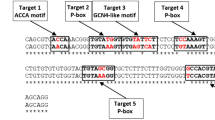Abstract
The enzyme trytophan decarboxylase (TDC) (EC 4.1.1.28) converts tryptophan into tryptamine, and thereby channels primary metabolites into indole alkaloid biosynthesis. The production of these secondary metabolites in suspension cells of Catharanthus roseus depends on medium composition. Of the possible variables, we investigated the effect of hormones on the expression of the tdc gene in cell cultures. Omission of NAA from the growth medium resulted in accumulation of tdc mRNA. The addition of 1-naphthaleneacetic acid (NAA), indoleacetic acid (IAA) or 2,4-dichlorophenoxyacetic acid (2,4-D) rapidly reduced the enhanced tdc transcript level. Cytokinin was unable to suppress the enhanced transcript level. Hairy roots transformed by Agrobacterium rhizogenes also showed a reduction of the tdc mRNA level after NAA addition. Run-off transcription experiments showed that the down-regulation takes place at the transcriptional level within 15 minutes and independent of de novo protein synthesis. Thus one of the mechanisms which control the activity of terpenoid indole alkaloid biosynthesis in C. roseus cell cultures is the negative regulation by auxin of the gene involved in the first committed step.
Similar content being viewed by others
References
Bell, EA: The physiological role(s) of secondary (natural) products. In: Conn, EE (ed) The Biochemistry of Plants: A Comprehensive Treatise, pp. 1–17. Academic Press, New York (1981).
Berlin, J, Forche, E, Wray, V, Hammer, J, Hösel, W: Formation of benzophenanthridine alkaloids by suspension cultures of Eschscholtzia californica. Z Naturforsch, Teil C 38: 346–352 (1983).
DeLuca, V, Marineau, C, Brisson, N: Molecular cloning and analysis of cDNA encoding a plant tryptophan decarboxylase: Comparison with animal dopa decarboxylases. Proc Natl Acad Sci USA 86: 2582–2586 (1989).
Diamond, MI, Miner, JN, Yoshinaga, SK, Yamamoto, KR: Transcription factor interactions: Selectors of positive or negative regulation from a single DNA element. Science 249: 1266–1272 (1990).
Feinberg, AP, Vogelstein, B: A technique for radiolabeling DNA restriction endonuclease fragments to high specific activity. Anal Biochem 137: 266–267 (1984).
Gamborg, OL, Miller, RA, Ojima, K: Nutrient requirements of suspension cultures of soybean root cells. Exp Cell Res 50: 151–158 (1968).
Hagen, G, Guilfoyle, TJ: Rapid induction of selective transcription by auxins. Mol Cell Biol 5: 1197–1203 (1985).
Hay, CA, Anderson, LA, Roberts, MF, Phillipson, JD: Akaloid production by plant cell cultures. In: Mizrahi, A (ed) Biotechnology in agriculture, Advances in Biotechnological processes, pp. 97–140. Alan R. Liss, New York (1988).
Kernan, A, Thornburg, RW: Auxin levels regulate the expression of a wound-inducible proteinase inhibitor II-chloramphenicol acetyl transferase gene fusion in vitro and in vivo. Plant Physiol 91: 73–78 (1989).
Knobloch, KH, Berlin, J: Influence of medium composition on the formation of secondary compounds in cell suspension cultures of Catharanthus roseus (L.) G. Don. Z Naturforsch 35c: 551–556 (1980).
Knobloch, KH, Hansen, B, Berlin, J: Medium-induced formation of indole alkaloids and concomitant changes of interrelated enzyme activities in cell suspension cultures of Catharanthus roseus. Z Naturforsch 36c: 40–43 (1981).
Lamb, CJ, Lawton, MA, Dron, M, Dixon, RA: Signals and transduction mechanisms for activation of plant defences against microbial attack. Cell 56: 215–224 (1989).
Linsmaier, EM, Skoog, F: Organic growth factor requirements of tobacco tissue cultures. Physiol Plant 18: 100–127 (1965).
Lounasmaa, M, Galambos, J: Indole alkaloid production in Catharanthus roseus cell suspension cultures. In: Herz, W, Grisebach, H, Kirby, GW, Tamm, C (eds) Progress in the chemistry of organic natural products, pp. 89–115. Springer-Verlag, Wien (1989).
Maniatis, T, Fritsch, EF, Sambrook, J: Molecular Cloning. Cold Spring Harbor, Harbor Laboratory Press, NY (1982).
Noé, W, Berlin, J: Induction of de novo synthesis of tryptophan decarboxylase in cell suspensions of Catharanthus roseus. Planta 166: 500–504 (1985).
Noé, W, Mollenschott, C, Berlin, J: Tryptophan decarboxylase from Catharanthus roseus cell suspension cultures: purification, molecular and kinetic data of the homogenous protein. Plant Mol Biol 3: 281–288 (1984).
Ozeki, Y, Komamine, A, Tanaka, Y: Induction and repression of phenylalanine ammonia-lyase and chalcone synthase enzyme proteins and mRNAs in carrot cell suspension cultures regulated by 2,4-D. Physiol Plant 78: 400–408 (1990).
Pasquali, G, Goddijn, OJM, deWaal, A, Verpoorte, R, Schilperoort, RA, Hoge, JHC, Memelink, J: Coordinated regulation of two indole alkaloid biosynthetic genes from Catharanthus roseus by auxin and elicitors. Plant Mol Biol 18: 1121–1131 (1992).
Reddy, ASN, Poovaiah, BW: Molecular cloning and sequencing of a cDNA for an auxin-repressed mRNA: correlation between fruit growth and repression of the auxin-regulated gene. Plant Mol Biol 14: 127–136 (1990).
Sasse, F, Bucholz, M, Berlin, J: Selection of cell lines of Catharanthus roseus with increased tryptophan decarboxylase activity. Z Naturforsch 38c: 910–915 (1983).
Southern, E: Detection of specific sequences among DNA fragments separated by gel electrophoresis. J Mol Biol 98: 503–517 (1975).
van derHeijden, R, Verpoorte, R, tenHoopen, HJG: Cell and tissue cultures of Catharanthus roseus (L.) G. Don: a literature survey. Plant Cell Tissue Organ Cult 18: 231–280 (1989).
van derZaal, EJ, Memelink, J, Mennes, AM, Quint, A, Libbenga, KB: Auxin-induced mRNA species in tobacco cell cultures. Plant Mol Biol 10: 145–157 (1987).
vanSlogteren, GMS, Hoge, JHC, Hooykaas, PJJ, Schilperoort, RA: Clonal analysis of heterogeneous crown gall tumor tissues induced by wild-type and shooter mutant strains of Agrobacterium tumefaciens expression of T-DNA gene. Plant Mol Biol 2: 321–333 (1983).
Zenk, MH, El-Shagi, H, Arens, H, Stockigt, J, Weiler, EW, Deuss, B: Formation of the indole alkaloids serpentine and ajmalicine in cell suspension cultures of Catharanthus roseus. In: Barz, W, Reinhard, E, Zenk, MH (eds) Plant Tissue Culture and its Biotechnological Application, pp. 27–44. Springer-Verlag, Berlin (1977).
Author information
Authors and Affiliations
Rights and permissions
About this article
Cite this article
Goddijn, O.J.M., de Kam, R.J., Zanetti, A. et al. Auxin rapidly down-regulates transcription of the tryptophan decarboxylase gene from Catharanthus roseus . Plant Mol Biol 18, 1113–1120 (1992). https://doi.org/10.1007/BF00047714
Received:
Accepted:
Issue Date:
DOI: https://doi.org/10.1007/BF00047714




